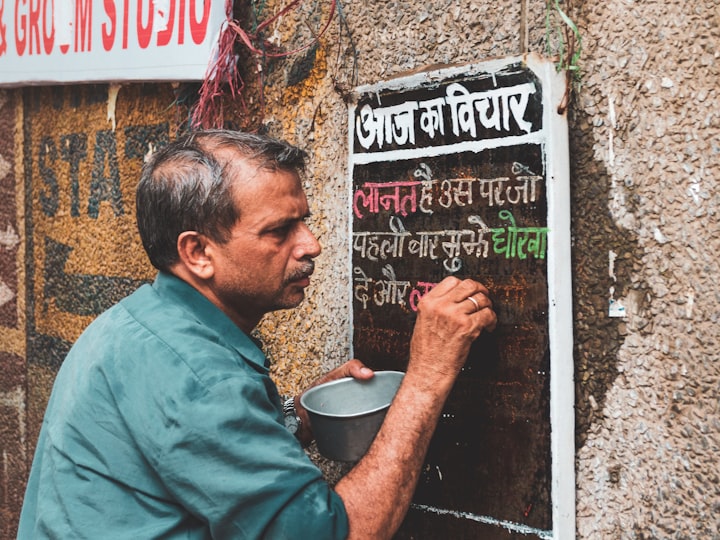Versatility in Hindi phonetics
Arun Kumar Ph.D.

Phonetics as defined in Fromkin et al. (2001) is the study of linguistic sounds. Its three components comprise of articulatory phonetics: the study of linguistic sound pronunciation; auditory or perceptual phonetics: the study of how sound is perceived; and finally acoustic phonetics: the study of physical aspects of speech sounds. Phonetics aims to provide sets of properties that can be used to describe and distinguish all sounds used in human language. This essay examines the versatile nature and diversity of articulatory and auditory phonetics in Hindi.
The articulatory phonetic description refers to six factors. These include air stream, vocal folds, soft palate, place of articulation, manner of articulation and lips (Crystal, 1997). The production of any sound is created by lung air pushed through glottis (vocal cord), the opening of the larynx (the voice box), through the pharynx, and out of the oral cavity through the mouth or nose. Since lung air is used, these sounds are called pulmonic and since the air is pushed out, they are called egressive. Sometimes air is sucked in instead of being pushing out which in turn creates ingressive sounds such as implosives and clicks (Fromkin et al., 2001).
All speech sounds are either consonants or vowels. Consonants are produced with some obstruction of the airstream in the supraglottal cavities and are distinguished according to where they are articulated in the vocal tract. Two reference points are involved in defining consonantal places of articulation: the part of vocal tract that moves (the active articulator) and the part with which it makes contact (the passive articulator). The eleven places of articulation include bilabial, labio-dental, dental, alveolar, retroflex, palato-alveolar, palatal, velar, uvular, pharyngeal and glottal (Crystal, 1997).
Vowels are distinguished from consonants in terms of how they are articulated in the vocal tract, and the associated patterns of acoustic energy. Consonants are defined as sounds made by a closure in the vocal tract, whereas vowels are sounds that have no such stricture: air escapes in a relatively unimpeded way through the mouth or nose. Vowels are easier to distinguish on auditory grounds (Crystal, 1997).
Various languages have their own distinct phonetic components. Normally pronunciation of a word is represented by its spelling alphabets. However, this is not always true in several languages. There are hundreds of thousands of words in different languages where discrepancies exist between spelling alphabets and their sound. Such languages are not predominantly phonetic languages. Some languages are very phonetic, such as Hindi, Sanskrit, and other languages of India, while some others are predominantly non phonetic, such as French. English has a mixture of words that are both phonetic and non-phonetic.
Hindi is a rich and melodic language. It belongs to Indo-Aryan variety, Indo-Iranian sub-family, and Indo-European family of languages (Crystal, 1997). It is also India’s national language where it is widely spoken as first and second language. Modern Hindi co-exists in northern and central India with regional forms of speech closely cognate to it and with many local dialects, as well as with Urdu (McGregor, 1997).
In 1991, 48% (337,272,114 people) of India’s population called Hindi as their mother tongue (Central Institute of Indian Languages, ciil website). Crystal (1997) placed Hindi in fourth place (223 million people speak both Hindi and Urdu) among the top 40 languages in the world. Bright (1992) and Grimes (1996) estimate that there are over 350 million Hindi speakers in the world. Hindi speaking people form a significant proportion of population in South Asian countries, East African countries, South Africa, Mauritius, Fiji, Guyana, Singapore, Surinam and Trinidad and Tobago. During the past century, Hindi speaking people have migrated in significant numbers to United Arab Emirates, Yemen and other Arab countries, United Kingdom and other countries of Western Europe, United States of America, Canada, Australia, and New Zealand. At present, Hindi is spoken by approximately one billion people around the world.
Hindi is a phonetic language in which the way a word is spelled corresponds to the way it is pronounced, and vice-versa. There are no silent letters in Hindi words. It has fourteen vowels, thirty-six consonants and nine conjunct consonants. A combination of these vowels and consonants produces a wide array of possible sounds. Hindi is written in Devanagari (language of the Devine city) script, whose basic component is the aksara (syllable), typically a consonant-vowel unit. All symbols of the syllabic alphabet are arranged in an order based on the phonetics of Sanskrit. The vowels come first followed by the consonants. The vowels are arranged as primary vowels followed by secondary vowels. There are three special symbols that modify Hindi sound. Firstly, virama or vowel suppressor is used to suppress the inherent vowel of a syllable. Secondly, anusvara (dot) and chandrabindu (moon-and-dot) are nasalization markers. Finally, visarga indicates that a sound has breathy quality or a breath marker (Hindi Guru website).
The order of the letters in Hindi is based on articulatory phonetics. Consonant letters carry an inherent vowel which can be altered or muted by means of a diacritic or matra. Vowels can be written as independent letters or by using a variety of diacritical marks that can be written above, below, before or after the consonant they belong to (Omniglot website). All the Hindi vowels come in two versions in the script: full vowel and vowel sign. The vowel sign is much simpler than the full vowel and is used when a vowel follows a consonant. If a vowel follows another vowel, or if a word starts with a vowel, the full vowel is used. There is no pronunciation difference between full vowels and vowel signs. Hindi consonants are classified as the velar, the palatal, the retroflex, the dental and the labial depending on where in the mouth they are formed. First consonants are the plosives in four combinations of voiceless and voiced versions, followed by a nasal consonant (Omniglot website).
The Hindi vowel sounds are diverse and complex. Inherent to each consonant-based syllable is a vowel, usually [a], for example, the ‘k’ based syllable is by default pronounced as [ka]. In order to write a [ki] syllable, the inherent [a] vowel must be overridden by an [i] vowel. While the consonant-based syllable is the mainstay of the alphabet, a syllable can also consist of a sole vowel (Omniglot website).
The sound of velar consonants k, kh, g, gh and unga are produced when the back of the tongue articulates with the soft palate. Likewise sound of palatal consonants ch, chh, j, jh and yan are produced when front of the tongue articulates with the hard palate. The retroflex consonants t, th, d, dh and n are produced when the tip of the tongue is curled back to articulate with the area between the rear of the alveolar ridge and the front of the hard palate. The dental consonants t, th, d, dh and n are produced when the tongue tip and rims articulate with the upper teeth (Crystal, 1997). Verma and Chawla (2004) carried out a comparative analysis of Hindi retroflex and dental consonants. It comprised of an accurate description of their acoustic characteristics and the differences between the corresponding cognate sounds in the two classes. The sound of labial consonants p, ph, b, bh and m are produced when both lips are involved in the articulation (Crystal, 1997). In addition to these consonants there are many sonorants, sibilants, and conjunct consonants in Hindi.
Such a large and varied system of vowel and consonant sounds characterizes Hindi. The large array of sounds created by combining various vowels and consonants makes Hindi a phonetic language capable of producing a wide variety of sounds produced by human beings. This makes Hindi easy to learn, read, write, and speak.
References
Bright, W. (Ed.). (1992). International Encyclopedia of Linguistics. New York and Oxford, D.U.P.
CIIL Website (http://www. Ciil.org/languages/Indian.html)
Crystal, D. (1997). The Cambridge Encyclopedia of Language. Cambridge University Press.
Fromkin, V., Rodman, R., Hultin, N., & Logan, H. (2001). An Introduction to Language. Thomson. Second Canadian Edition.
Grimes, B. F. (Ed.). (1996). Ethnologue: Languages of the World, 13th Edition. Dallas.
Hindi Guru Website (http://www.specialitysoftware.com/hguru/index.htm)
Omniglot Website (http://www.omniglot.com/writing/devanagari.htm)
McGregor, R. S. (1997). Oxford Hindi-English Dictionary. Oxford University Press.
Verma, R. and Chawla, P. (2004). Comparative analysis of Hindi retroflex and dental CV syllables and their synthesis. (Online article read on October 1, 2004).
About the Creator
Arun Kumar Ph. D.
I am a semi-retired geologist, presently affiliated with Carleton University, Ottawa, Canada. During my almost five decades long career I worked around the world. Now I live in Ottawa, the beautiful capital city of Canada.





Comments
There are no comments for this story
Be the first to respond and start the conversation.